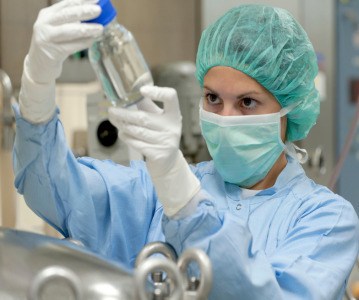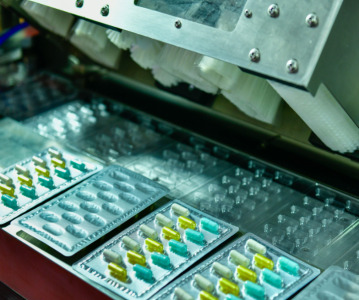Novel method for organoid production and storage to accelerate drug development research

Researchers develop method to produce organoid materials for disease and drug development research.
A team of researchers at Cincinnati Children’s, a hospital and medical centre, have developed a method to consistently make and freeze material required for lab-grown organoids to help accelerate drug development research.
Organoids consist of individualized collections of cells derived from stem cells that resemble a patient’s own tissues. As a result, organoids can be utilized to replicate complex organ tissues and systems as a research tool for therapeutic and drug development. However, bottlenecks continue to persist in development of organoids for such research purposes. For example, one batch of starting material may yield a large quantity of organ precursor cells while another batch of starting material may yield little to none. Such inconsistencies can lead to pipeline delays for preclinical trials during drug development.
The research team at Cincinnati Children’s thus developed a method to overcome such inconsistencies in early-stage organoid formation. In a typical setting, organoid production begins with the collection of skin or blood cells, which are then converted to iPSCs utilized to grow a layer of precursor cells. Ideally, these early-stage organoids spontaneously form 3D balls of cells that are then collected and transferred to a growth medium that provides necessary conditions to grow a specific organ cell type. The novel method developed by the researchers instead places the unused precursor cells in a centrifuge which drive the cells into wells, prompting the formation of 3D cell aggregates. These are then collected and utilized for organoid production. Spheroids created with this method were demonstrated to have no significant difference than those grown spontaneously. Precursor cells were also placed into freezers for storage. Once thawed, the precursor cells continued to form viable spheroids. This method has made possible the mass production of organoids with increased consistency.
Amy Pitstick, manager of the Pluripotent Stem Cell Facility at Cincinnati Children’s, commented:
“This method can make organoids a more accessible tool…We show that the aggregation approach consistently produces high yields and we have proven that precursor cells can be thawed from cryogenic storage to produce organoids of the small intestine.”
Michael Helmrath, Director of Clinical Translation for the Center for Stem Cell & Organoid Medicine, added:
“This is a great step forward for the field on many fronts… To be able to reduce the complexity of the process and provide higher yields is beneficial to our work and to be able to translate the methods to other labs will help move regenerative medicine forward.”
Related News
-
News A Day in the Life of Oncology Start-Up Co-Founder & CEO
This Women's month we are highlighting stories of women in the pharma industry (building on what we do every month to support women), so for the Day in the Life of we are speaking to Sharon Cunningham who is the Co-founder and CEO of Shorla On... -
News Women in Pharma: Manufacturing personal and team success
Our monthly Women in Pharma series highlights the influential lives and works of impactful women working across the pharmaceutical industry, and how the industry can work towards making the healthcare industry and workplace more equitable and inclusive... -
News A Day in the Life of a Head of Market Insights in med devices
The latest interview in the Day in the Life of Series is with Alper Hulusi, Head of Market Insights for ClariMed. Hulusi also works to try to get to know people, this time from the other side of pharma – the people that will be using the the... -
News CPHI Podcast Series: Packaging expert perspectives at Pharmapack 2025
This month's podcast episode sounds a little different, covering the latest event in Paris – Pharmapack 2025. Digital Editor Lucy Chard speaks to several experts direct from the floor of the show, bringing you right in on the action.&nbs... -
News Vertex Pharmaceuticals stock jumps as FDA approves non-opioid painkiller
UK-based Vertex Pharmaceuticals saw their stock shares soar as the US FDA signed off on the non-opioid painkiller Journavx, also known as suzetrigine, for patients with moderate to severe acute pain, caused by surgery, accidents, or injuries. -
News The 2025 Pharmapack Awards: recognising innovation and patient centricity
This year in Paris the Pharmapack Awards recognised the achievements across categories in the industry, aswell as including some new categories to highlight exceptional work and people. -
News Pharmapack 2025: From the Floor in Paris
Pharmpack gears up for another week in Paris at the Porte De Versailles. The two-day show taking place on the 22–23 January, will cover contract packaging, device innovation, and sustainability among other topics. -
News Visibility, Integration, and Opportunity with CPOs: A Pharmapack Interview
At Pharmapack 2025 in Paris the informative content tracks this year will feature a Contract Packaging track. A critically important topic for those working in the field, which speaker Alexander Schäfer from Sharp Services discusses in the fo...
Recently Visited
Position your company at the heart of the global Pharma industry with a CPHI Online membership
-
Your products and solutions visible to thousands of visitors within the largest Pharma marketplace
-
Generate high-quality, engaged leads for your business, all year round
-
Promote your business as the industry’s thought-leader by hosting your reports, brochures and videos within your profile
-
Your company’s profile boosted at all participating CPHI events
-
An easy-to-use platform with a detailed dashboard showing your leads and performance










